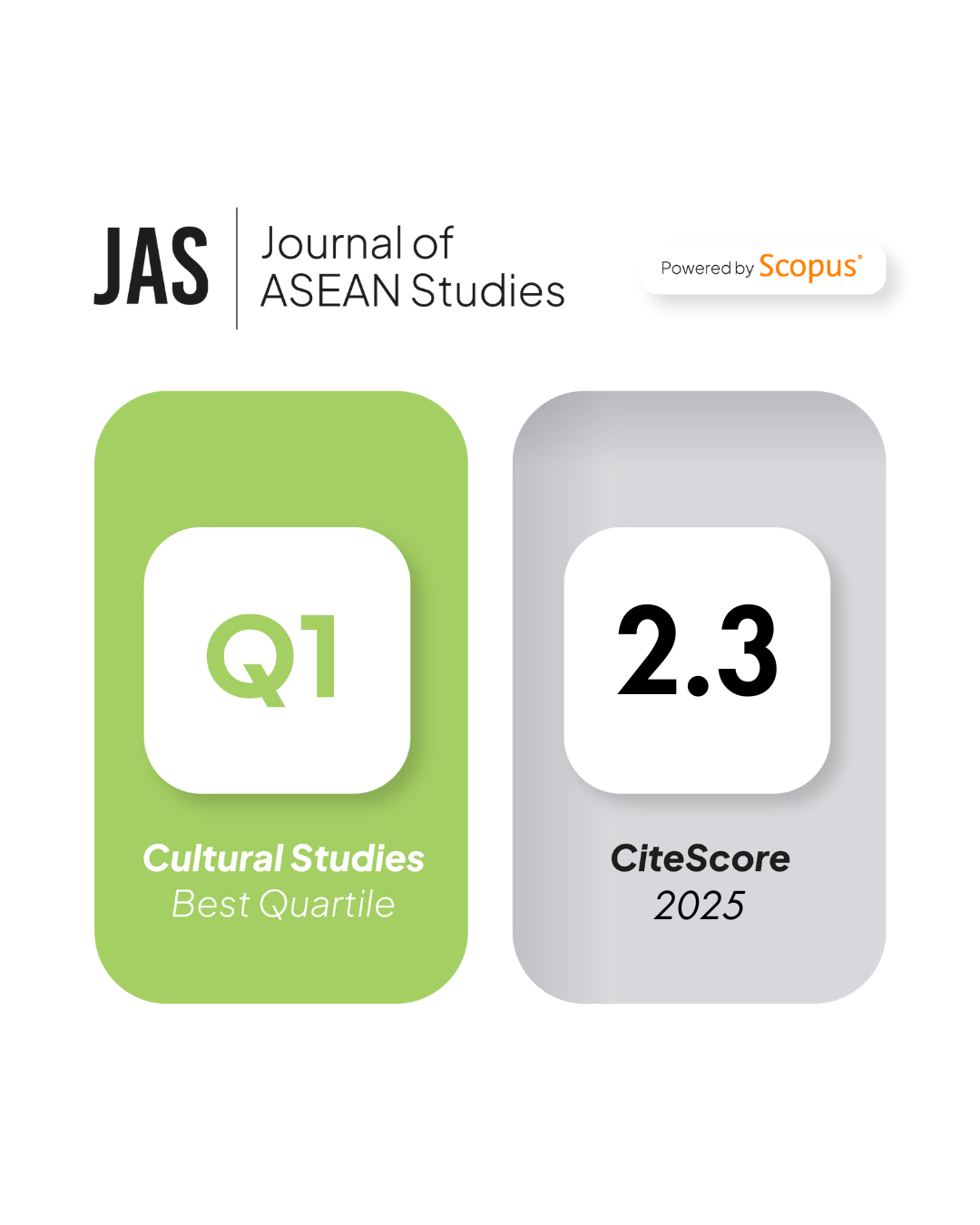Institutional Factors and FDI Inflows in ASEAN-7: A Bayesian Approach
DOI:
https://doi.org/10.21512/jas.v13i1.12399Keywords:
ASEAN-7, Bayesian, FDI inflow, Institutional factorsAbstract
Unlike previous research, which typically relied on frequency statistics, the research applies Bayesian regression to examine the impact of institutional factors on Foreign Direct Investment (FDI) inflows in the ASEAN-7 countries from 2002 to 2022. Counterintuitively, yet consistent with the unique context of the ASEAN-7, where institutional quality is relatively weak, the findings indicate that three institutional factors—control of corruption, rule of law, and voice and accountability—exerted a negative influence on FDI inflows. This suggests that strong anti-corruption measures, a robust rule of law, and high levels of voice and accountability do not necessarily attract more FDI in these countries. Only political stability and absence of violence/terrorism and Regulatory quality exhibited a positive correlation with FDI inflows, while Government effectiveness showed no significant impact. Robustness checks using Feasible generalized least squares estimation were conducted to ensure the reliability of the results and provide a solid foundation for policy implications. These findings underscore the intriguing possibility that countries with weaker institutional frameworks can compete effectively with developed economies in attracting FDI, a key driver of economic growth. Given the relatively low level of institutional quality in the ASEAN-7, other non-institutional factors may play a more prominent role in attracting FDI. Moreover, enhancing institutional quality to attract more FDI, as commonly perceived, requires a nuanced understanding of the specific conditions of each host country and necessitates further research on home country characteristics.
References
Abotsi, A. K. (2016). Theory of foreign direct investment and corruption. International Journal of Asian Social Science, 6(6), 359-378. https://doi.org/10.18488/journal.1/2016.6.6/1.6.359.378
Aisen, A., & Veiga, F. J. (2013). How does political instability affect economic growth? European Journal of Political Economy, 29, 151-167. https://doi.org/10.1016/j.ejpoleco.2012.11.001
Alesina, A.,Özler, S.,Roubini, N., & Swagel, P. (1996). Political instability and economic growth. Journal of Economic growth, 1, 189-211. https://doi.org/10.1007/BF00138862
Alexander, J. (2014, August 31). Foreign direct investment, the rule of law, and the new institutionalism: Explaining FDI in the developing world [Meeting paper]. APSA 2014 Annual Meeting Paper.
Ali, N., Phoungthong, K., Khan, A., Abbas, S., Dilanchiev, A., Tariq, S., & Sadiq, M. N. (2023). Does FDI foster technological innovations? Empirical evidence from BRICS economies. Plos one, 18(3), e0282498. https://doi.org/10.1371/journal.pone.0282498
Allen, F.,Qian, J., & Qian, M. (2005). Law, finance, and economic growth in China. Journal of Financial Economics, 77(1), 57-116. https://doi.org/10.1016/j.jfineco.2004.06.010
Ansari, A., Jedidi, K., & Dube, L. (2002). Heterogeneous factor analysis models: A Bayesian approach. Psychometrika, 67, 49-77. https://doi.org/10.1007/BF02294709
Assaf, A. G., & Tsionas, M. (2021). A Bayesian solution to multicollinearity through unobserved common factors. Tourism Management, 84, 104277. https://doi.org/10.1016/j.tourman.2020.104277
Aswicahyono, H., Bird, K., & Hill, H. (2009). Making economic policy in weak, democratic, post-crisis states: An Indonesian case study. World Development, 37(2), 354-370. https://doi.org/10.1016/j.worlddev.2008.06.007
Awadhi, M., James, M., & Byaro, M. (2022). Does institutional development attract foreign direct investments in Sub-Saharan Africa? A dynamic panel analysis. African Journal of Economic Review, 10(1), 117-129.
Bailey, N. (2018). Exploring the relationship between institutional factors and FDI attractiveness: A meta-analytic review. International Business Review, 27(1), 139-148. https://doi.org/10.1016/j.ibusrev.2017.05.012
Bardhan, P. (2017). Corruption and development: a review of issues. In A. J. Heidenheimer & M. Johnston (Eds.), Political corruption: Concepts and contexts. Routledge
Bayes, T. (1958). An essay towards solving a problem in the doctrine of chances. Biometrika, 45(3-4), 296-315.
Bénassy‐Quéré, A., Coupet, M., & Mayer, T. (2007). Institutional determinants of foreign direct investment. The World Economy, 30(5), 764-782. https://doi.org/10.1111/j.1467-9701.2007.01022.x
Bhujabal, P., Sethi, N., & Padhan, P. C. (2024). Effect of institutional quality on FDI inflows in South Asian and Southeast Asian countries. Heliyon, 10(5). https://doi.org/10.1016/j.heliyon.2024.e27060
Bickerdyke, I., & Lattimore, R. (1997). Reducing the regulatory burden: Does firm size matter? Industry Commission.
Boatright, J. R. (2000). Ethics and the conduct of business (8th ed.) Pearson Education India.
Borozan, D., Bayar, Y., & Gavriletea, M. D. (2022). Do stringent environmental and business regulations, and uncertainty matter for foreign direct investment inflows? Evidence from G7 and BRICS economies. Economic Research-Ekonomska Istraživanja, 36(2). https://doi.org/10.1080/1331677X.2022.2142638
Bouchoucha, N., & Benammou, S. (2020). Does institutional quality matter foreign direct investment? Evidence from African countries. Journal of the Knowledge Economy, 11(1), 390-404. https://doi.org/10.1007/s13132-018-0552-y
Buchanan, B. G., Le, Q. V., & Rishi, M. (2012). Foreign direct investment and institutional quality: Some empirical evidence. International Review of Financial Analysis, 21, 81-89. https://doi.org/10.1016/j.irfa.2011.10.001
Busse, M., & Hefeker, C. (2007). Political risk, institutions and foreign direct investment. European Journal of Political Economy, 23(2), 397-415. https://doi.org/10.1016/j.ejpoleco.2006.02.003
Carment, D.,Landry, J.,Samy, Y., & Shaw, S. (2017). Towards a theory of fragile state transitions: evidence from Yemen, Bangladesh and Laos. In R. M. Gisselquist, Fragility, aid, and state-building (pp. 48-64). Routledge.
Cetin, M. A., & Yaman, I. (2023). The importance of geopolitical risk and institutional quality indicators on foreign direct investment to BRICS countries. Romanian Journal of Economic Forecasting, 26(4), 107-127.
Cheung, P.,George, A., & Zhang, X. (2023). Foreign direct investments in emerging Asia: An evaluation of pandemic and policy shocks. Routledge.
Corcoran, A., & Gillanders, R. (2015). Foreign direct investment and the ease of doing business. Review of World Economics, 151, 103-126. https://doi.org/10.1007/s10290-014-0194-5
Dang, V. C., & Nguyen, Q. K. (2021). Determinants of FDI attractiveness: Evidence from ASEAN-7 countries. Cogent Social Sciences, 7(1). https://doi.org/10.1080/23311886.2021.2004676
Demena, B. A., & van Bergeijk, P. A. G. (2017). A meta‐analysis of FDI and productivity spillovers in developing countries. Journal of Economic Surveys, 31(2), 546-571. https://doi.org/10.1111/joes.12146
Dunning, J. H. (2013). Trade, location of economic activity and the multinational enterprise: A search for an eclectic approach. In J. Dunning, International Production and the Multinational Enterprise (RLE International Business). Routledge
Ear, S. (2007). The political economy of aid and governance in Cambodia. Asian Journal of Political Science, 15(1), 68-96. https://doi.org/10.1080/02185370701315624
Ear, S. (2016). Combating corruption in Cambodia. Asian Education and Development Studies, 5(2), 159-174. https://doi.org/10.1108/AEDS-01-2016-0004
Elish, E. (2022). Political and productive capacity characteristics as outward foreign direct investment push factors from BRICS countries. Humanities and Social Sciences Communications, 9(1), 1-10. https://doi.org/10.1057/s41599-022-01460-6
Faruq, A. (2023). The determinants of foreign direct investment (FDI) A panel data analysis for the emerging Asian economies. arXiv e-prints, arXiv-2307. https://doi.org/10.48550/arXiv.2307.07037
Feng, Y. (2017). Determinants of foreign direct investment (FDI). In Oxford Research Encyclopedia of Politics. https://doi.org/10.1093/acrefore/9780190228637.013.559
Ferrara, F. (2015). The political development of modern Thailand. Cambridge University Press.
Gangi, Y. A., & Abdulrazak, R. S. (2012). The impact of governance on FDI flows to African countries. World Journal of Entrepreneurship, Management and Sustainable Development, 8(2-3), 162-169. https://doi.org/10.1108/20425961211247761
Gani, A. (2007). Governance and foreign direct investment links: Evidence from panel data estimations. Applied Economics Letters, 14(10), 753-756. https://doi.org/10.1080/13504850600592598
Gelman, A., & Rubin, D. B. (1992). Inference from iterative simulation using multiple sequences. Statistical science, 7(4), 457-472. https://doi.org/10.1214/ss/1177011136
Ghaderinezhad, F., Ley, C., & Loperfido, N. (2020). Bayesian inference for skew-symmetric distributions. Symmetry, 12(4), 491. https://doi.org/10.3390/sym12040491
Gonchar, K., & Greve, M. (2022). The impact of political risk on FDI exit decisions. Economic systems, 46(2), 100975. https://doi.org/10.1016/j.ecosys.2022.100975
Gong, M., Mao, Z., Zhang, D., Ren, J., & Zuo, S. (2023). Study on Bayesian skew-normal linear mixed model and its application in fire insurance. Fire Technology, 59(5), 2455-2480. https://doi.org/10.1007/s10694-023-01436-1
Goswami, G. G., & Haider, S. (2014). Does political risk deter FDI inflow? An analytical approach using panel data and factor analysis. Journal of Economic Studies, 41(2), 233-252. https://doi.org/10.1108/JES-03-2012-0041
Gregory, R. (2016). Combating corruption in Vietnam: A commentary. Asian Education and Development Studies, 5(2), 227-243. https://doi.org/10.1108/AEDS-01-2016-0010
Ha, T. C., & Nguyen, H. N. (2021). The role of institution on FDI and environmental pollution nexus: evidence from developing countries. The Journal of Asian Finance, Economics and Business, 8(6), 609-620. https://doi.org/10.13106/jafeb.2021.vol8.no6.0609
Hale, G., & Xu, M. (2016, September). FDI effects on the labor market of host countries. (Federal Reserve Bank of San Francisco Working Paper 2016-2025). http://www.frbsf.org/economicresearch/publications/working-papers/wp2016-25.pdf
Hansen, H., & Rand, J. (2006). On the causal links between FDI and growth in developing countries. The World Economy, 29(1), 21-41. https://doi.org/10.1111/j.1467-9701.2006.00756.x
Hebous, S., Kher, P., & Tran, T. T. (2020). Regulatory risk and FDI. In The World Bank, Global investment competitiveness report 2019/2020: Rebuilding investor confidence in times of uncertainty (pp. 128-169).
Henderson, J. V., & Kuncoro, A. (2004, August). Corruption in Indonesia. (NBER Working Paper No. 10674). https://doi.org/10.3386/w10674
Henisz, W. J. (2000). The institutional environment for multinational investment. Journal of Law, Economics, and Organization, 16(2), 334-364. https://doi.org/10.1093/jleo/16.2.334
Henisz, W. J., & Williamson, O. E. (1999). Comparative economic organization—within and between countries. Business and Politics, 1(3), 261-277. https://doi.org/10.1515/bap.1999.1.3.261
Hill, H., & Shiraishi, T. (2007). Indonesia after the Asian crisis. Asian Economic Policy Review, 2(1), 123-141. https://doi.org/10.1111/j.1748-3131.2007.00058.x
Hoff, K. R., & Stiglitz, J. E. (2005). The creation of the rule of law and the legitimacy of property rights: the political and economic consequences of a corrupt privatization (NBER Working Paper No. 11772).
Iamsiraroj, S. (2016). The foreign direct investment–economic growth nexus. International Review of Economics & Finance, 42, 116-133. https://doi.org/10.1016/j.iref.2015.10.044
Iešmantas, T., & Alzbutas, R. (2016). Bayesian analysis of heterogeneous reliability data for vulnerability assessment. Safety and Reliability, (36)1, 13-23. https://doi.org/10.1080/09617353.2016.1148921
Intal Jr, P. S., & Chen, L (Ed..). (2017). ASEAN@ 50 Volume 3: ASEAN and member states: transformation and integration. ERIA.
Jensen, N. (2008). Political risk, democratic institutions, and foreign direct investment. The Journal of Politics, 70(4), 1040-1052. https://doi.org/10.1017/S0022381608081048
Jurčić, L.,Franc, S., & Barišić, A. (2020). Impact of institutional quality on foreign direct investment inflow: Evidence from Croatia. Business Systems Research Journal, 11(1), 44-58. https://doi.org/10.2478/bsrj-2020-0004
Kastratović, R. (2020). The impact of foreign direct investment on host country exports: A meta‐analysis. The World Economy, 43(12), 3142-3183. https://doi.org/10.1111/twec.13011
Kaufmann, D., & Kraay, A. (2023). Worldwide Governance Indicators, 2023 Update.
Kaufmann, D., Kraay, A., & Mastruzzi, M. (2003). Government matters III: Governance indicators for 1996-2002. (Policy Research Working Paper No. 3106).
Kaushal, L. A. (2021). Impact of institutional and regulatory quality on FDI inflow: Case of a developing Indian economy. Cogent Economics & Finance, 9(1). https://doi.org/10.1080/23322039.2021.1985201
Khan, H., Dong, Y., Bibi, R., & Khan, I. (2023). Institutional quality and foreign direct investment: Global evidence. Journal of the Knowledge Economy, 15, 10547–10591. https://doi.org/10.1007/s13132-023-01508-1
Khan, H., Weili, L., & Khan, I. (2022). The role of institutional quality in FDI inflows and carbon emission reduction: evidence from the global developing and belt road initiative countries. Environmental Science and Pollution Research, 29, 30594–30621 . https://doi.org/10.1007/s11356-021-17958-6
Kim, H. (2010). Political stability and foreign direct investment. International Journal of Economics and Finance, 2(3), 59-71. https://doi.org/10.5539/ijef.v2n3p59
Kraft, H. J. S. (2003). The Philippines: The weak state and the global war on terror. Kasarinlan: Philippine Journal of Third World Studies, 18(1), 133-152.
Kutan, A. M., & Vukšić, G. (2007). Foreign direct investment and export performance: empirical evidence. Comparative Economic Studies, 49, 430-445. https://doi.org/10.1057/palgrave.ces.8100216
Lai, J. L. (2021). A tale of two treaties: A study of NAFTA and the USMCA's investor-state dispute settlement mechanisms. Emory Internationall Law Review, 35(2), 259-296.
Le, A. H., & Kim, T. (2021). The impact of institutional quality on FDI inflows: The evidence from capital outflow of Asian economies. The Journal of Asian Finance, Economics and Business, 8(8), 335-343. https://doi.org/10.13106/jafeb.2021.vol8.no8.0335
Lee, H. H., & Tan, H. B. (2006). Technology transfer, FDI and economic growth in the ASEAN region. Journal of the Asia Pacific Economy, 11(4), 394-410. https://doi.org/10.1080/13547860600923593
Lee, S.-Y.,Poon, W.-Y., & Song, X.-Y. (2007). Bayesian analysis of the factor model with finance applications. Quantitative Finance, 7(3), 343-356. https://doi.org/10.1080/14697680601009838
Leff, N. H. (1964). Economic development through bureaucratic corruption. American Behavioral Scientist, 8(3), 8-14. https://doi.org/10.1177/000276426400800303
Lin, C., & Wong, S. M. L. (2013). Government intervention and firm investment: Evidence from international micro-data. Journal of International Money and Finance, 32, 637-653. https://doi.org/10.1016/j.jimonfin.2012.06.002
Lintner, B. (2008). Laos: At the crossroads. Southeast Asian Affairs, 2008, 171-183.
Manalo, E. P. (2004). The Philippine response to terrorism: The Abu Sayyaf Group. [Postgraduate Thesis, Naval Postgraduate School].
Martin, G. M.,Frazier, D. T.,Maneesoonthorn, W.,Loaiza-Maya, R.,Huber, F.,Koop, G.,Maheu, J.,Nibbering, D., & Panagiotelis, A. (2024). Bayesian forecasting in economics and finance: A modern review. International Journal of Forecasting, 40(2), 811-839. https://doi.org/10.1016/j.ijforecast.2023.05.002
Mauro, P. (1995). Corruption and growth. The Quarterly Journal Of Economics, 110(3), 681-712. https://doi.org/10.2307/2946696
Mengistu, A. A., & Adhikary, B. K. (2011). Does good governance matter for FDI inflows? Evidence from Asian economies. Asia Pacific Business Review, 17(3), 281-299. https://doi.org/10.1080/13602381003755765
Méon, P. G., & Sekkat, K. (2004). Does the quality of institutions limit the MENA's integration in the world economy? The World Economy, 27(9), 1475-1498. https://doi.org/10.1111/j.0378-5920.2004.00661.x
Minović, J., Stevanović, S., & Aleksić, V. (2021). The relationship between foreign direct investment and institutional quality in Western Balkan countries. Journal of Balkan and Near Eastern Studies, 23(1), 40-61. https://doi.org/10.1080/19448953.2020.1818038
Moosa, I. (2002). Foreign direct investment: Theory, evidence and practice. Palgrave Macmillan London.
Moustafa, E. (2021). The relationship between perceived corruption and FDI: A longitudinal study in the context of Egypt. Transnational Corporations, 28(2), 97-129.
Nguyen, T. N.,Duong, M. H. T., & Van Nguyen, D. (2024). Natural resources and the underground economy: A cross-country study in ASEAN using Bayesian approach. E&M Economics and Management, 27(2), 1-15. https://doi.org/10.15240/tul/001/2024-2-001
Nizam, I., & Hassan, Z. (2018). The impact of good governance of foreign direct investment inflows: A study on the South Asia region. International Journal of Accounting & Business Management, 6(1), 66-79.
North, D. C. (1990). Institutions, institutional change and economic performance. Cambridge University.
North, D. C., & Weingast, B. R. (1989). Constitutions and commitment: The evolution of institutions governing public choice in seventeenth-century England. The Journal Of Economic History, 49(4), 803-832. https://doi.org/10.1017/S0022050700009451
Paap, R. (2002). What are the advantages of MCMC based inference in latent variable models? Statistica Neerlandica, 56(1), 2-22. https://doi.org/10.1111/1467-9574.00060
Phoong, S.-Y., & Ismail, M. T. (2015). A comparison between Bayesian and maximum likelihood estimations in estimating finite mixture model for financial data. Sains Malaysiana, 44(7), 1033-1039.
Putra, N. R., & Linda, R. (2022). Corruption in Indonesia: A challenge for social changes. Integritas: Jurnal Antikorupsi, 8(1), 13-24. https://doi.org/10.32697/integritas.v8i1.898
Quazi, R.,Vemuri, V., & Soliman, M. (2014). Impact of corruption on foreign direct investment in Africa. International Business Research, 7(4). https://doi.org/10.5539/ibr.v7n4p1
Rose-Ackerman, S., & Tobin, J. (2005). Foreign direct investment and the business environment in developing countries: The impact of bilateral investment treaties. Yale Law & Economics Research Paper(293).
Sabir, S.,Rafique, A., & Abbas, K. (2019). Institutions and FDI: Evidence from developed and developing countries. Financial Innovation, 5, 1-20. https://doi.org/10.1186/s40854-019-0123-7
Sachdev, R. (2006). Comparing the Legal Foundations of Foreign Direct Investment in India and China: Law and the Rule of Law in the Indian Foreign Direct Investment Context. Columbia Business Law Review, 2006(1). https://doi.org/10.7916/cblr.v2006i1.2986
Sadeghi, P., Shahrestani, H., Kiani, K. H., & Torabi, T. (2020). Economic complexity, human capital, and FDI attraction: A cross country analysis. International Economics, 164, 168-182. https://doi.org/10.1016/j.inteco.2020.08.005
Saha, S., Sadekin, M. N., & Saha, S. K. (2022). Effects of institutional quality on foreign direct investment inflow in lower-middle income countries. Heliyon, 8(10), e10828. https://doi.org/10.1016/j.heliyon.2022.e10828
Shaari, M. S.,Esquivias, M. A.,Ridzuan, A. R.,Fadzilah Zainal, N., & Sugiharti, L. (2022). The impacts of corruption and environmental degradation on foreign direct investment: New evidence from the ASEAN+ 3 countries. Cogent Economics & Finance, 10(1). https://doi.org/10.1080/23322039.2022.2124734
Shamsub, H. (2023). The impact of FDI on innovation in developing countries: The mediating role of governance. International Journal of Finance, Economics and Business, 2(3), 178-194. https://doi.org/https://doi.org/10.56225/ijfeb.v2i3.141
Shan, S.,Lin, Z.,Li, Y., & Zeng, Y. (2018). Attracting Chinese FDI in Africa: The role of natural resources, market size and institutional quality. Critical perspectives on international business, 14(2-3), 139-153. https://doi.org/10.1108/cpoib-11-2016-0055
Shivute, P. (2008). The rule of law in sub-Saharan Africa –An overview. In N. Horn, & A. Basl (Eds.), Human Rights and the Rule of Law in Namibia (pp. 213-219). Macmillan Namibia.
Smith, A. F., & Roberts, G. O. (1993). Bayesian computation via the Gibbs sampler and related Markov chain Monte Carlo methods. Journal of the Royal Statistical Society: Series B (Methodological), 55(1), 3-23. https://doi.org/10.1111/j.2517-6161.1993.tb01466.x
Syukri, A. U., Hasanuddin, B., Paddu, A. H., & Suhab, S. (2022). Impact of government spending and corruption on foreign direct investment in Indonesia. Research Papers in Economics and Finance, 6(1), 34-45. https://doi.org/10.18559/ref.2022.1.3
Tanzi, V., & Davoodi, H. (1998). Corruption, public investment, and growth. In The welfare state, public investment, and growth: selected papers from the 53rd congress of the International Institute of Public Finance (pp. 41-60).
Thanh, B. D., Diep, N. V., & Tram, N. H. M. (2024). Impacts of financial development and green trade on the shadow economy: An insight of eagle countries using Bayesian approaches. Plos One, 19(5). https://doi.org/10.1371/journal.pone.0303135
Tocar, S. (2018). Determinants of foreign direct investment: A review. Review of Economic and Business Studies (REBS), 11,(1), 165-196.
Tokunaga, M., & Iwasaki, I. (2017). The determinants of foreign direct investment in transition economies: A meta‐analysis. The World Economy, 40(12), 2771-2831. https://doi.org/10.1111/twec.12477
Vadlamannati, K. C. (2012). Impact of political risk on FDI revisited—An aggregate firm-level analysis. International Interactions, 38(1), 111-139. https://doi.org/10.1080/03050629.2012.640254
Vortherms, S. A., & Zhang, J. J. (2024). Political risk and firm exit: Evidence from the US–China Trade War. Review of International Political Economy, 31(6), 1814-1839. https://doi.org/10.1080/09692290.2024.2351841
Wagenmakers, E.-J., Marsman, M., Jamil, T., Ly, A.,Verhagen, J., Love, J., Selker, R., Gronau, Q. F., Šmíra, M., & Epskamp, S. (2018). Bayesian inference for psychology. Part I: Theoretical advantages and practical ramifications. Psychonomic bulletin & review, 25, 35-57. https://doi.org/10.3758/s13423-017-1343-3
Wagenmakers, E. J.,Verhagen, J.,Ly, A.,Matzke, D.,Steingroever, H.,Rouder, J. N., & Morey, R. D. (2017). The need for Bayesian hypothesis testing in psychological science. In S. O. Lilienfeld & I. D. Waldman (Eds.), Psychological science under scrutiny: Recent challenges and proposed solutions (pp. 123-138). John Wiley & Sons, Inc. https://doi.org/10.1002/9781119095910.ch8
Wang, X., Xu, L. C., & Zhu, T. (2012). Foreign direct investment under a weak rule of law: Theory and evidence from China. Economics of Transition, 20(3), 401-424. https://doi.org/10.1111/j.1468-0351.2012.00436.x
Williams, J. M. (2020). The hydropower myth. Environmental Science and Pollution Research, 27(12), 12882-12888. https://doi.org/10.1007/s11356-019-04657-6
Xin, Y. (2024). Application of Bayesian based statistical prediction in financial data analysis. In 2024 7th International Conference on e-Education, e-Business and Information Management (EEIM 2024).
Younsi, M., & Bechtini, M. (2019). Do institutions and good governance affect inward FDI? Empirical evidence from emerging countries. (MPRA Paper No. 94815)
Downloads
Published
How to Cite
Issue
Section
License
Copyright (c) 2025 Duy Khanh Le

This work is licensed under a Creative Commons Attribution-NonCommercial 4.0 International License.






















